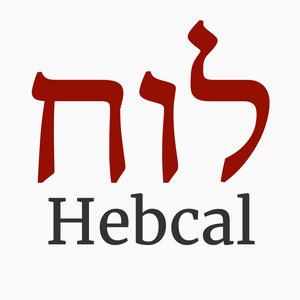Your comments
Thanks for the bug report! We've very sorry for the breakage. The issue has been fixed and event titles are once again in Russian.
Thanks. I was looking at a couple of different versions of the Ezras Torah luach today, and I see they list following two different ways of announcing (see below, highlighting mine).
I checked the Miles Cohen Luach (used by the conservative movement) and I didn't find molad announcements at first glance.
I think we can improve how Molad times are rendered. Picking a compact form like "Wednesday, 7:18am and 7 chalakim" might be preferred over the long form announced in synagogue.
From Ezras Torah luach 5781:
Thus, the
traditional way of announcing the Molad
for MarCheshvan would be to announce:
"The Molad for MarCheshvan will be
Shabbos morning, twenty three minutes
after 3." (The times of Molad is in Israel,
see page 70).
"The Molad for MarCheshvan will be
Shabbos morning, twenty three minutes
after 3."
And from 5780:
THE TIMES OF
מולדות THE NEW MOON
The Molads are announced by the
Gabbai at the time of the Blessing of the
New Month, which takes place on the
Shabbos before Rosh Chodesh (with the
exception of the month of Tishrei whose
Molad is not announced). The time for
the Molad of each month is traditionally
expressed in the days, minutes, and
Chalokim after the hour. (A Cheilek, the
smallest traditional measurement of
the time, is 1/1080 of an hour, or 1/18
of a minute, which amounts to a little
more than three seconds.) Thus, the
traditional way of announcing the
Molad for MarCheshvan would be to
announce: “The Molad for MarCheshvan
will be Monday, Oct. 28, 6:34 PM and
6 Chalokim.” (The times of Molad is in
Israel, see page 67).
TISHREI: – Sunday, Sep. 29, 5:50 AM
and 5 Chalokim.
MARCHESHVAN: – Monday, Oct. 28
6:34 PM and 6 Chalokim.
KISLEV: – Wednesday, Nov. 27, 7:18
AM and 7 Chalokim.
TEVES: – Thursday, Dec. 26, 8:02 PM
and 8 Chalokim.
SHEVAT: – Saturday, Jan. 25, 8:46 AM
and 9 Chalokim.
ADAR: – Sunday, Feb. 23, 9:30 PM
and 10 Chalokim.
NISAN: – Tuesday, March 24, 10:14
AM and 11 Chalokim.
IYAR: – Wednesday, April 22, 10:58
PM and 12 Chalokim.
SIVAN: – Friday, May 22, 11:42 AM
and 13 Chalokim.
TAMUZ: – Sunday, June 21, 12:26 AM
and 14 Chalokim.
AV: – Monday, July 20, 1:10 PM. and
15 Chalokim.
ELUL: – Wednesday, August 19, 1:54
AM and 16 Chalokim.
We have added Molad times to the Hebrew Date converter. They appear on the Shabbat prior to Rosh Chodesh.
On weekdays, the sections from Prophets and Writings in Tanakh Yomi are recited according to the ancient Masoretic division of sedarim. Hebcal uses the section divisions as published by Sefaria.org.
For example, looking at recent days:
Friday, 24 October 2025
Joshua 14:15-17:3
Sunday, 26 October 2025
Joshua 17:4-18:27
Monday, 27 October 2025
Joshua 18:28-19:50
Indeed, the Masoretic sectional divisions seem closely but not perfectly aligned with modern chapter divisions.
I'm not an expert in why and how the Masoretic sectional divisions differ from modern chapter divisions.
Thanks for the bug report; we're terribly sorry about this error. It has been fixed. Please try again.
Thanks for your message. What you're seeing in iOS 26 is a feature of Apple's operating system called Alternate Calendars and not something that Hebcal.com controls.
If you don't wish to see the Hebrew date in Hebrew, you can disable the Hebrew calendar on iOS 26 following Apple's instructions:
Change how your calendar is displayed
You can customize the way your calendar is displayed to help highlight the information that’s most important to you. For example, you can choose which day you want to start the week with, display the Chinese, Hebrew, or Hijri calendar (alongside the Gregorian calendar), and more.
- Go to the Settings app
 on your iPhone.
on your iPhone. - Tap Apps, then tap Calendar.
- Do any of the following:
- Display the Chinese, Hebrew, or Hijri calendar: Tap Alternate Calendars, then choose a calendar.
- Display the week number next to every week of the year: Turn on Week Numbers.
- Show the current day as the first day in Week view: Turn on Week View Starts On Today.
- Choose a different day to start the week: Tap Start Week On, then tap a day.
Thanks for the suggestion about adding molad times to the Hebrew date converter.
If you'd like to see historical molad, you can use the undocumented molad=1 URL parameter on the Custom Calendar page like this:
Molad times are displayed in the "memo" field of our Shabbat Mevarchim calendar feed
https://www.hebcal.com/ical/#heading-mevarchim
Molad days and times on Hebcal.com are always listed with respect to the time in Jerusalem
Does this help?
Hi, thanks for contacting us!
The Hebcal website and APIs support 13 different languages for event titles. By default, Hebcal uses Sephardic transliterations. To transliterate event titles in a different language, specify lg=LANG parameter using one of the following values listed on this page.
https://www.hebcal.com/home/4534/jewish-calendar-event-language-support
If you're seeing Ashkenazic transliterations, this means that your site is using lg=a or possibly a very old a=on API parameter.
Change to lg=s and remove any occurrences of a=on and you'll be all set!
Customer support service by UserEcho


Hi, sorry to hear you are having difficulty changing the name on a personal Yahrzeit calendar. Have you tried following the instructions on this page?
https://www.hebcal.com/home/632/how-to-make-changes-to-a-yahrzeit-anniversary-calendar
if you have tried these instructions and you’re still having trouble, please send your private calendar URL via email to support@hebcal.com and we can help diagnose further.